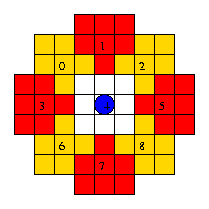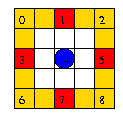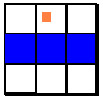Astrocytes: Movement and Effects
In the initial versions of the AD simulation, the role played by astrocytes
was largely that of cytokine secretion, and its eventual impact
on neuronal health. After consultation with experts (Prof P McGeer) and
recent literature on astrocyte movement (see
Kornyei et al, 2000) it has become
clearer that astrocytes can move, and that they "gather at the site of
plaques" (See Itagaki et al 1989), though
details of the motion is as yet unclear. Sections of AD brain tissue reveal
distinct astrocytic clustering at plaques, and depletion of astrocytes
from adjoining regions, suggesting strongly a process of accumulation of
these cells at plaque locations over time.
In considering the process of maturation of AD plaques from diffuse to
compact, a secondary effect of astrocytes is now incorporated: their ability
to locally seal-off or block sites. The details of this mechanism, too, are
under investigation. Currently, we allow astrocytes in a highly activated
form to move towards amyloid fibers, and to change the local properties
of the tissue. The sealing-off of the site of astrocyte aggregation
affects local diffusion of cytokines and amyloid.
The details incorporated in the simulation are described below.
Rules for Astrocytes
States
In the simulation, an astrocyte can be in one of four states:
- inactive - in this state the astrocyte is quiescent.
The state changes to an active state once the IL-1B concentration exceeds a
threshold (designated by the activation level parameter).
The astrocytes then absorb IL-1B (by receptor-mediated kinetics)
and secrete IL-6 and TNF.
- receptive - in this state the astrocyte is active but immobile.
Due to long, highly ramified branches, it is able to sense a region
approximately 40 microns in radius from its cell body.
Once the absorbed IL-1B concentration exceeds a threshold
(designated by IL-1B threshold for motility) the cell
may move some short distance (e.g. approach or grow
towards putative plaque); see movement, described below, for details.
- motile - moving closer to, or changing morphology to
approach site of a plaque. In this state, the morphology of the astrocyte
has changed: branches are shorter, and the region sampled extends only
20 microns from the cell body.
- blocking - becoming immobilized at the site of a plaque
and affecting the local properties of the tissue. See further details below.
Movement
The position of an astrocyte is checked and updated every n time steps
where n is calculated based on the maximum speed parameter,
(in units of microns/min). [Remark: The program automatically
converts this value into number of time steps based on the size of a grid
space and the duration of a time step.]
Only cells that are receptive or motile can move.
In order for astrocytes to move, they must have absorbed enough
IL-1B to exceed the IL-1B threshold for motility.
The directions of motion on the grid are labeled as follows:
0 1 2
3 4 5
6 7 8
where "4" denotes the current position of the cell. Sensing which direction
to move is different for receptive and motile cells based on
the fact that the astrocyte's branches are different lengths in the two
states.
When the astrocyte is receptive it samples the
average fiber density in a circular region that extends
40 microns away from its position. Direction of motion is
determined as follows:

Each region shown above corresponds to a direction of movement. The
astrocyte will
move in the direction of maximal fiber density with a probability given by
the probability of moving towards stimulus parameter. If the
probability for moving towards the stimulus is not met, then the
astrocyte will move randomly. The astrocyte will
move in the determined direction as long as there is room (i.e. the
maximum density is not exceeded and there are no microglia present).
If no fiber is detected, then the cell will not move.
When the astrocyte is motile its sampling region,
shown below, is smaller.

After sampling the eight regions, the astrocyte may
move in the direction of maximum fiber density with probability given
by the probability of moving towards stimulus parameter.
This also means that there is some probability of moving in a random
direction. Movement occurs only if there is room.
If no fiber is detected, the cell will remain in place,
and revert to the receptive state. A moving
astrocyte remains in the motile state.
These rules for movement are preliminary and will be refined as more
information on biological details of astrocyte movement
becomes available.
Blocking
The presence of fibrillar amyloid
in adjoining grid spaces (represented by white
spaces in the diagrams shown above) may cause the
astrocyte state to change to blocking,
a term used loosely to represent the walling-off effect of astrocytic
secretions. When astrocytes encounter fibrillar amyloid
in an adjoining grid space, each astrocyte (there may be more
than one due to the fact that each astrocyte represents some
astrocyte concentration) will become a blocker based
on the probability of blocking parameter. For each
cell that becomes a blocker, the local chemical diffusivitives
are decreased in accordance with the reduction percentage
for diffusivities parameter.
Currently the effect is felt in the central grid space and the neighboring
grid spaces that are normal to the direction of maximum fiber concentration.
In the case where the fiber (shown in orange) is detected in a grid space that
is diagonal to the astrocyte (in the center), the grid spaces that are affected
are shown in blue below

When the fiber is not diagonal, the affected grid spaces look like the one shown
below

The locally decreased diffusivities result in a build up of the chemicals,
especially the IL-6 and TNF secreted by astrocytes. In some cases,
this leads to a wave of neuronal death propagating from blocking astrocytes.
Many of these details are still in preliminary form, and
will be changed in the future.




